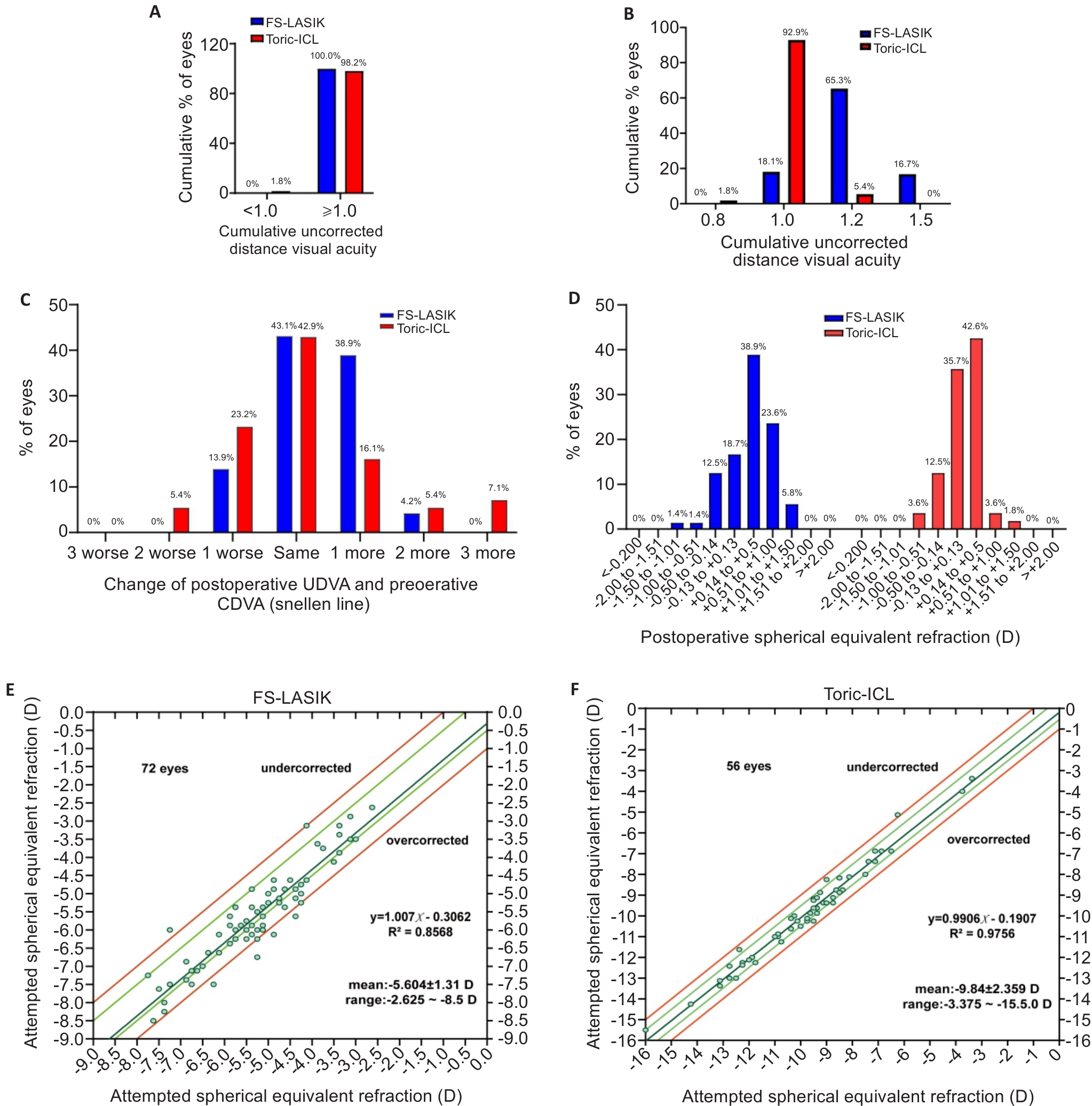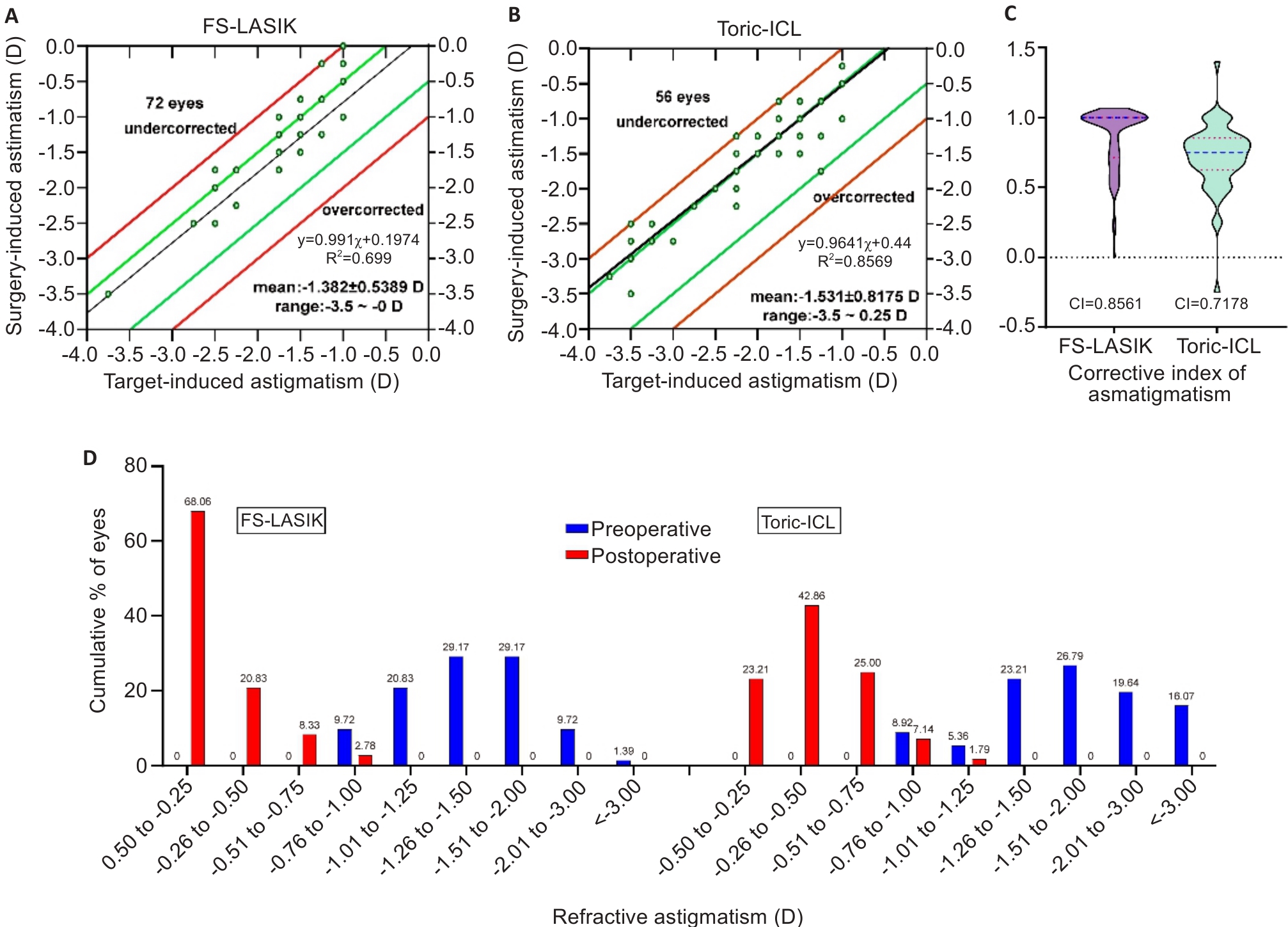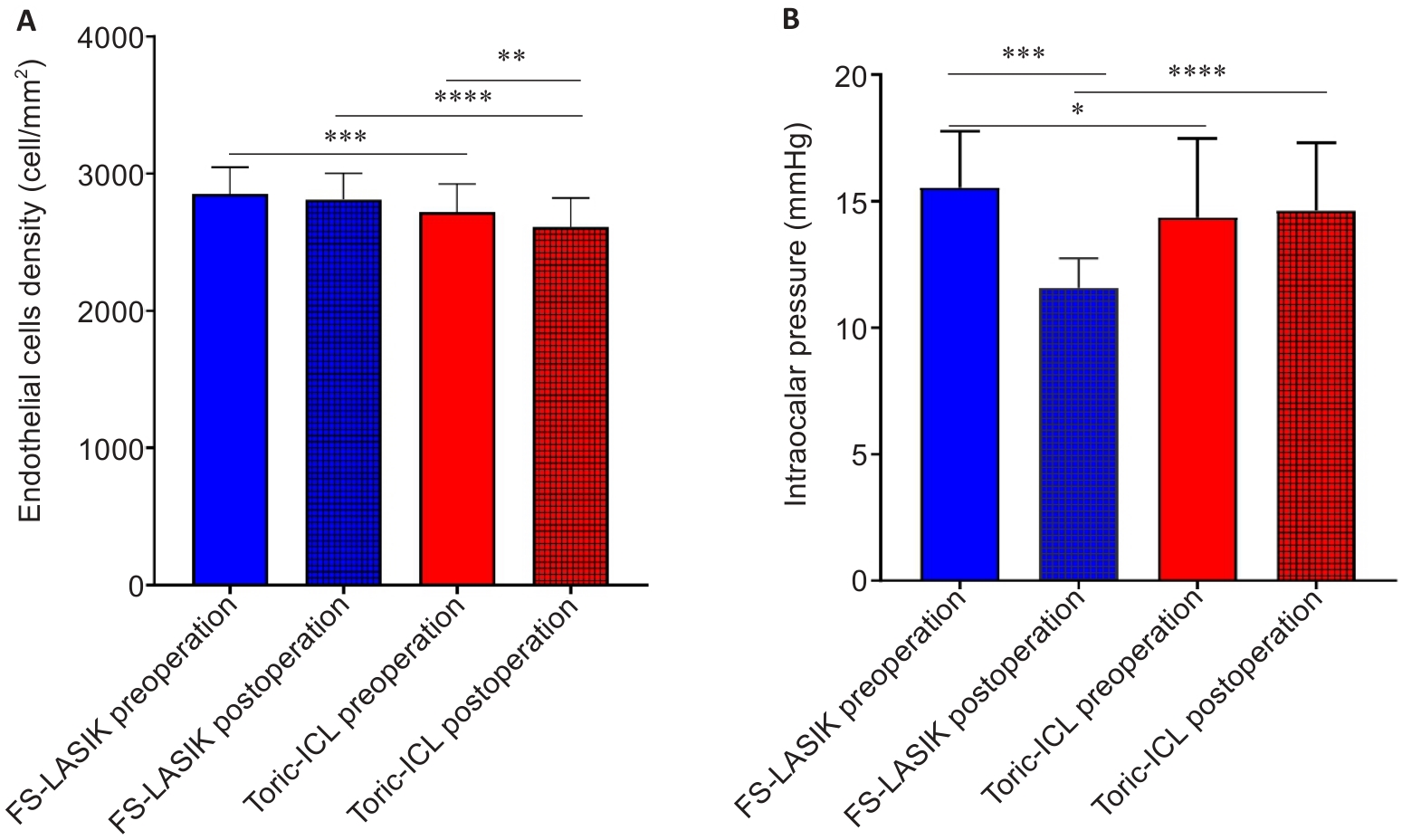Journal of Southern Medical University ›› 2025, Vol. 45 ›› Issue (6): 1113-1121.doi: 10.12122/j.issn.1673-4254.2025.06.01
Hongyang LI( ), Wenxiong LIAO, Peng LEI, Chunyuan YANG, Yanying LI, Liping XUE, Duo TAN, Sijing LIU, Yi WU(
), Wenxiong LIAO, Peng LEI, Chunyuan YANG, Yanying LI, Liping XUE, Duo TAN, Sijing LIU, Yi WU( ), Meilan CHEN(
), Meilan CHEN( )
)
Received:2024-08-03
Accepted:2025-04-10
Online:2025-06-20
Published:2025-06-27
Contact:
Yi WU, Meilan CHEN
E-mail:362342650@qq.com;13332877439@189.com;13332877439@189.cn;meilanchen918@163.com
Supported by:Hongyang LI, Wenxiong LIAO, Peng LEI, Chunyuan YANG, Yanying LI, Liping XUE, Duo TAN, Sijing LIU, Yi WU, Meilan CHEN. Toric-ICL shows better predictability and efficacy than FS-LASIK for myopia correction in patients with moderate to high myopia and astigmatism[J]. Journal of Southern Medical University, 2025, 45(6): 1113-1121.
Add to citation manager EndNote|Ris|BibTeX
URL: https://www.j-smu.com/EN/10.12122/j.issn.1673-4254.2025.06.01

Fig.1 Refractive outcomes of the patients at 6 months after the operation. A, B: Distribution of uncorrected distance visual acuity (UDVA) 6 months after operation in the two groups. C: Changes of postoperative UDVA and preoperative CDVA. D: Distribution of postoperative spherical equivalent (SE) in the two groups. E, F: Attempted SE refractive change plotted against the achieved SE refractive change.

Fig.2 Astigmatism analysis of the patients after the operation. A, B: Target-induced astigmatic change plotted against the surgery-induced astigmatic change. C: Corrective index of astigmatism is 0.8561 in FS-LASIK group and 0.7176 in T-ICL group (P<0.0001). D: Astigmatic distribution before and after operation in the two groups.

Fig.4 Changes in corneal endothelial cell density (A) and intraocular pressure (B) after the operation in the two groups. *P<0.05, **P<0.01, ***P<0.001, ****P<0.0001.
| 1 | Bullimore MA, Ritchey ER, Shah S, et al. The risks and benefits of myopia control [J]. Ophthalmology, 2021, 128(11): 1561-79. doi:10.1016/j.ophtha.2021.04.032 |
| 2 | Tran D, Heinrich C, Ali SF. The myopia epidemic: treatment options in the pediatric population [J]. Int Ophthalmol Clin, 2022, 62(1): 231-40. doi:10.1097/iio.0000000000000404 |
| 3 | Sugar A, Hood CT, Mian SI. Patient-reported outcomes following LASIK: quality of life in the PROWL studies [J]. JAMA, 2017, 317(2): 204-5. doi:10.1001/jama.2016.19323 |
| 4 | Kim TI, Alió Del Barrio JL, Wilkins M, et al. Refractive surgery [J]. Lancet, 2019, 393(10185): 2085-98. doi:10.1016/s0140-6736(18)33209-4 |
| 5 | Ganesh S, Brar S, Pawar A. Matched population comparison of visual outcomes and patient satisfaction between 3 modalities for the correction of low to moderate myopic astigmatism [J]. Clin Ophthalmol, 2017, 11: 1253-63. doi:10.2147/OPTH.S127101 |
| 6 | Guell JL, Morral M, Kook D, et al. Phakic intraocular lenses part 1: historical overview, current models, selection criteria, and surgical techniques [J]. J Cataract Refract Surg, 2010, 36(11): 1976-93. doi:10.1016/j.jcrs.2010.08.014 |
| 7 | Nagy ZZ. New technology update: femtosecond laser in cataract surgery [J]. Clin Ophthalmol, 2014, 8: 1157-67. doi:10.2147/opth.s36040 |
| 8 | Ang M, Gatinel D, Reinstein DZ, et al. Refractive surgery beyond 2020 [J]. Eye (Lond), 2021, 35(2): 362-82. doi:10.1038/s41433-020-1096-5 |
| 9 | Chang JS, Meau AY. Visian Collamer phakic intraocular lens in high myopic Asian eyes [J]. J Refract Surg, 2007, 23(1): 17-25. doi:10.3928/1081-597x-20070101-05 |
| 10 | Price MO, Price FW. Evaluation of the toric implantable collamer lens for simultaneous treatment of myopia and astigmatism [J]. Expert Rev Med Devices, 2015, 12(1): 25-39. doi:10.1586/17434440.2015.984685 |
| 11 | Nakamura T, Isogai N, Kojima T, et al. Posterior chamber phakic intraocular lens implantation for the correction of myopia and myopic astigmatism: a retrospective 10-year follow-up study [J]. Am J Ophthalmol, 2019, 206: 1-10. doi:10.1016/j.ajo.2019.04.024 |
| 12 | Alfonso JF, Baamonde B, Madrid-Costa D, et al. Collagen copolymer toric posterior chamber phakic intraocular lenses to correct high myopic astigmatism [J]. J Cataract Refract Surg, 2010, 36(8): 1349-57. doi:10.1016/j.jcrs.2010.02.022 |
| 13 | Read SA, Collins MJ, Carney LG. A review of astigmatism and its possible genesis [J]. Clin Exp Optom, 2007, 90(1): 5-19. doi:10.1111/j.1444-0938.2007.00112.x |
| 14 | Alpins NA. New method of targeting vectors to treat astigmatism [J]. J Cataract Refract Surg, 1997, 23(1): 65-75. doi:10.1016/s0886-3350(97)80153-8 |
| 15 | Alpins N. Astigmatism analysis by the Alpins method [J]. J Cataract Refract Surg, 2001, 27(1): 31-49. doi:10.1016/s0886-3350(00)00798-7 |
| 16 | Alpins NA. A new method of analyzing vectors for changes in astigmatism [J]. J Cataract Refract Surg, 1993, 19(4): 524-33. doi:10.1016/s0886-3350(13)80617-7 |
| 17 | Abulafia A, Koch DD, Holladay JT, et al. Pursuing perfection in intraocular lens calculations: IV. Rethinking astigmatism analysis for intraocular lens-based surgery: suggested terminology, analysis, and standards for outcome reports [J]. J Cataract Refract Surg, 2018, 44(10): 1169-74. doi:10.1016/j.jcrs.2018.07.027 |
| 18 | Chen X, Shen Y, Xu H, et al. One-year natural course of corneal densitometry in high myopic patients after implantation of an implantable collamer lens (model V4c) [J]. BMC Ophthalmol, 2020, 20(1): 50. doi:10.1186/s12886-020-1320-x |
| 19 | Chen K, Hu Z, Zhou J, et al. Vector analysis of the effects of FS-LASIK and toric ICL for moderate to high astigmatism correction [J]. J Ophthalmol, 2018, 2018: 6952710. doi:10.1155/2018/6952710 |
| 20 | Shen Y, Chen X, Xian Y, et al. Safety of intraocular pressure measurement using air-puff tonometer after implantable collamer lens implantation [J]. J Cataract Refract Surg, 2022, 48(8): 900-5. doi:10.1097/j.jcrs.0000000000000886 |
| 21 | Moshirfar M, Bundogji N, Tukan AN, et al. Toric implantable collamer lens for the treatment of myopic astigmatism [J]. Clin Ophthalmol, 2021, 15: 2893-906. doi:10.2147/opth.s321095 |
| 22 | Santhiago MR, Kara-Junior N, Waring GOT. Microkeratome versus femtosecond flaps: accuracy and complications [J]. Curr Opin Ophthalmol, 2014, 25(4): 270-4. doi:10.1097/icu.0000000000000070 |
| 23 | Reinstein DZ, Archer TJ, Gobbe M. Accuracy and reproducibility of cap thickness in small incision lenticule extraction [J]. J Refract Surg, 2013, 29(12): 810-5. doi:10.3928/1081597x-20131023-02 |
| 24 | Hashem AN, El Danasoury AM, Anwar HM. Axis alignment and rotational stability after implantation of the toric implantable collamer lens for myopic astigmatism [J]. J Refract Surg, 2009, 25(10 ): S939-43. doi:10.3928/1081597X-20090915-08 |
| 25 | Kamiya K, Shimizu K, Aizawa D, et al. One-year follow-up of posterior chamber toric phakic intraocular lens implantation for moderate to high myopic astigmatism [J]. Ophthalmology, 2010, 117(12): 2287-94. doi:10.1016/j.ophtha.2010.03.054 |
| 26 | Sari ES, Pinero DP, Kubaloglu A, et al. Toric implantable collamer lens for moderate to high myopic astigmatism: 3-year follow-up [J]. Graefes Arch Clin Exp Ophthalmol, 2013, 251(5): 1413-22. doi:10.1007/s00417-012-2172-8 |
| 27 | Niu L, Miao H, Tian M, et al. One-year visual outcomes and optical quality of femtosecond laser small incision lenticule extraction and Visian Implantable Collamer Lens (ICL V4c) implantation for high myopia [J]. Acta Ophthalmol, 2020, 98(6): e662-e7. doi:10.1111/aos.14344 |
| 28 | Helmy H, Hashem O. Intraocular pressure calculation in myopic patients after laser-assisted in situ keratomileusis [J]. Clin Ophthalmol, 2020, 14: 509-16. doi:10.2147/opth.s239329 |
| 29 | Gelaw Y, Kollmann M, Irungu NM, et al. The influence of central corneal thickness on intraocular pressure measured by goldmann applanation tonometry among selected Ethiopian communities [J]. J Glaucoma, 2010, 19(8): 514-8. doi:10.1097/ijg.0b013e3181ca7708 |
| 30 | Cacho I, Sanchez-Naves J, Batres L, et al. Comparison of intraocular pressure before and after laser in situ keratomileusis refractive surgery measured with Perkins tonometry, noncontact tonometry, and transpalpebral tonometry [J]. J Ophthalmol, 2015, 2015: 683895. doi:10.1155/2015/683895 |
| 31 | Agudelo LM, Molina CA, Alvarez DL. Changes in intraocular pressure after laser in situ keratomileusis for myopia, hyperopia, and astigmatism [J]. J Refract Surg, 2002, 18(4): 472-4. doi:10.3928/1081-597x-20020701-11 |
| 32 | Yang Z, Miao N, Wang L, et al. Comparison of different correction formulas and measurement methods for the accurate determination of intraocular pressure after SMILE and FS-LASIK surgery [J]. BMC Ophthalmol, 2022, 22(1): 404. doi:10.1186/s12886-022-02620-7 |
| 33 | Alfonso JF, Fernández-Vega-Cueto L, Alfonso-Bartolozzi B, et al. Five-year follow-up of correction of myopia: posterior chamber phakic intraocular lens with a central port design [J]. J Refract Surg, 2019, 35(3): 169-76. doi:10.3928/1081597x-20190118-01 |
| [1] | . Gene expression profiles of myopic mouse scleral fibroblasts: a bioinformatics analysis based on single-cell RNA sequencing [J]. Journal of Southern Medical University, 2021, 41(7): 1087-1092. |
| Viewed | ||||||
|
Full text |
|
|||||
|
Abstract |
|
|||||